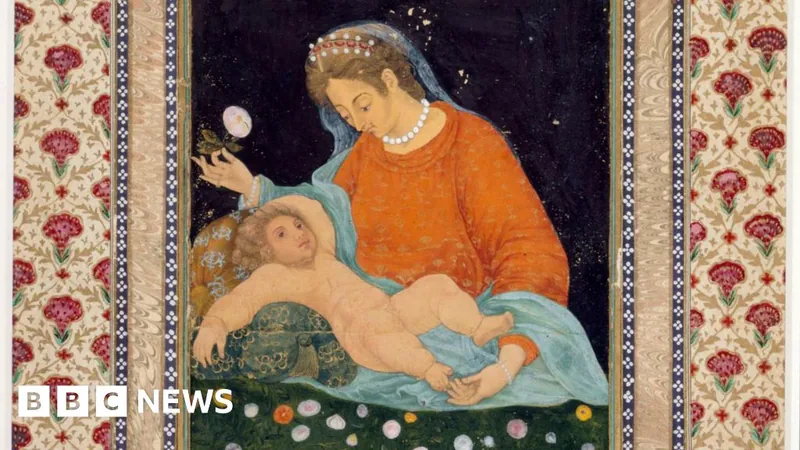
Christmas in India: A Unique Artistic Interpretation of Christ's Birth
2024-12-24
Author: Michael
Introduction
The birth of Jesus Christ—a pivotal moment in Christian history—has been immortalized through countless paintings by Western artists, often showcasing local beauty and cultural nuances. These depictions have become some of the most recognized representations of the nativity, shaping global perspectives while sidelining external influences, particularly from non-Western cultures.
Indian Artistic Interpretations
However, for centuries, Indian artists have been offering their own interpretations of this sacred event, infusing their works with local cultural aesthetics and spiritual insights. This creative endeavor represents a vibrant tapestry of artistic expression, breathing new life into the narratives of Christ's birth and Christianity itself.
Historical Context
One historical turning point for Christianity in India was the arrival of Jesuit missionaries during the reign of Mughal emperor Akbar in the late 16th century. Akbar’s openness to various religions led him to invite these missionaries to his court, where they introduced sacred texts and European artworks. This infusion of ideas prompted Mughal court painters to re-envision biblical scenes through a lens that combined Christian themes with the rich traditions of Islamic art.
Mughal Influence
Historian Neha Vermani points to a remarkable painting where Emperor Jahangir is depicted in the nativity scene, traditionally featuring the Holy Family. She notes, “Mughal rulers perceived themselves as 'just' sovereigns, striving to maintain harmony within their realms. Their legacy was defined by the coexistence of diverse faiths.” The style of such paintings, characterized by vibrant hues and ornate details, captures the essence of Mughal aesthetics while embracing Christian narratives.
Modern Artistic Contributions
In the modern era, the late Jamini Roy, born in 1887 in West Bengal, blended Bengali folk art with Kalighat paintings—art forms steeped in local traditions. Ashish Anand, CEO of art firm DAG, highlights that Roy interpreted Christ as a Santhal figure, resonating deeply with the simplicity and sacrifice inherent in Christ’s life. “Roy’s Christian-themed artwork holds as much significance as his representations of Hindu mythology, all executed in his uniquely modern folk style,” he explains.
Angelo de Fonseca
Also noteworthy is Angelo de Fonseca, born in Goa in 1902, who crafted an original Christian iconography that harmonized Eastern and Western influences with the Goan cultural milieu. In his artwork, Mary is not portrayed as the typical fair-skinned figure often seen in Western art but rather as an Indian woman, adorned in a sari and traditional jewelry. By setting biblical narratives against local landscapes and costumes, de Fonseca offered a resounding counter-narrative to the Western-centric view of Christianity.
Cultural Relevance
"Fonseca endeavored to root Christianity within the Indian context, challenging perceptions that it belongs solely to the West," asserts Rinald D'Souza, director of the Xavier Centre of Historical Research in Goa. His watercolor masterpieces transformed the interpretation of Christianity, making it more relatable and accessible to the Indian audience.
Conclusion
This unique engagement with the story of Christ's birth not only fosters a deeper understanding of religious themes but also celebrates India's artistic diversity—proving that Christmas can resonate in many forms across different cultures. As the world observes this sacred holiday, India's rich tapestry of artistic expression continues to remind us of the universal messages of compassion, love, and unity embedded in the story of the nativity.









 Brasil (PT)
Brasil (PT)
 Canada (EN)
Canada (EN)
 Chile (ES)
Chile (ES)
 España (ES)
España (ES)
 France (FR)
France (FR)
 Hong Kong (EN)
Hong Kong (EN)
 Italia (IT)
Italia (IT)
 日本 (JA)
日本 (JA)
 Magyarország (HU)
Magyarország (HU)
 Norge (NO)
Norge (NO)
 Polska (PL)
Polska (PL)
 Schweiz (DE)
Schweiz (DE)
 Singapore (EN)
Singapore (EN)
 Sverige (SV)
Sverige (SV)
 Suomi (FI)
Suomi (FI)
 Türkiye (TR)
Türkiye (TR)